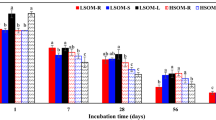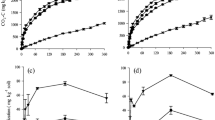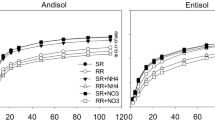Abstract
Purpose
Crop residue return is an effective and low-cost agricultural approach for soil organic carbon (SOC) sequestration. Yet, it is largely unknown to what extent the soil fertility and residue type affect the mineralization of maize (Zea mays L.) residue carbon (C) and the decomposition of native SOC. Therefore, a better understanding of the mineralization of C derived from residues and its priming on native SOC is crucial to accurate assessment of the benefits of crop residue returning in agricultural systems.
Materials and methods
A 360-day laboratory incubation experiment was carried out with a Cambisol of low and high fertilities amended with three types of 13C-labeled maize residues (root, stem, leaf). The abundance of 13C (δ13C) in the soil samples was measured during different incubation stages.
Results and discussion
The results showed that the total mineralization of residue C was significantly higher in the low fertility soil than in the high fertility soil, but there were no significant differences among residue types. For the high fertility soil, all the residue types induced a negative priming on native SOC mineralization during the early incubation stage, but a significant total positive priming by the end of incubation, whereas for the low fertility soil, there was no significant effect of residue return on SOC mineralization. The accumulated priming by the end of incubation did not vary across residue types. Moreover, the sum of mineralization of residue C and native SOC in the high fertility soil was 1.4 times as large as that in the low fertility soil.
Conclusions
We conclude that mineralization of crop residue C and native SOC is affected by soil fertility rather than residue type.




Similar content being viewed by others
References
Abbasi MK, Khaliq A (2016) Nitrogen mineralization of a loam soil supplemented with organic-inorganic amendments under laboratory incubation. Front Plant Sci 7:1–9
Abiven S, Recous S, Reyes V, Oliver R (2005) Mineralisation of C and N from root, stem and leaf residues in soil and role of their biochemical quality. Biol Fertil Soils 42:119–128
Agegnehu G, Bass AM, Nelson PN, Bird MI (2016) Benefits of biochar, compost and biochar-compost for soil quality, maize yield and greenhouse gas emissions in a tropical agricultural soil. Sci Total Environ 543:295–306
An T, Schaeffer S, Li S, Fu S, Pei J, Li H, Zhuang J, Radosevich M, Wang J (2015) Carbon fluxes from plants to soil and dynamics of microbial immobilization under plastic film mulching and fertilizer application using 13C pulse-labeling. Soil Biol Biochem 80:53–61
Aye NS, Butterly CR, Sale PWG, Tang C (2018) Interactive effects of initial ph and nitrogen status on soil organic carbon priming by glucose and lignocellulose. Soil Biol Biochem 123:33–44
Bell JM, Smith JL, Bailey VL, Bolton H (2003) Priming effect and C storage in semi-arid no-till spring crop rotations. Biol Fertil Soils 37:237–244
Bertrand I, Chabbert B, Kurek B, Recous S (2006) Can the biochemical features and histology of wheat residues explain their decomposition in soil? Plant Soil 281:291–307
Bingeman CW, Varner JE, Martin WP (1953) The effect of the addition of organic materials on the decomposition of an organic soil. Soil Sci Soc Am J 17:34–38
Blagodatskaya EV, Blagodatsky SA, Anderson TH, Kuzyakov Y (2007) Priming effects in Chernozem induced by glucose and N in relation to microbial growth strategies. Appl Soil Ecol 37:95–105
Castellano MJ, Mueller KE, Olk DC, Sawyer JE, Six J (2015) Integrating plant litter quality, soil organic matter stabilization, and the carbon saturation concept. Glob Chang Biol 21(9):3200–3209
Craine JM, Morrow C, Fierer N (2007) Microbial nitrogen limitation increases decomposition. Ecology 88:2105–2113
Dalenberg JW, Jager G (1989) Priming effect of some organic additions to 14C-labelled soil. Soil Biol Biochem 21:443–448
De Troyer I, Amery F, Van Moorleghem C, Smolders E, Merckx R (2011) Tracing the source and fate of dissolved organic matter in soil after incorporation of a 13C labelled residue: a batch incubation study. Soil Biol Biochem 43:513–519
Ehaliotis C, Cadisch G, Giller KE (1998) Substrate amendments can alter microbial dynamics and N availability from maize residues to subsequent crops. Soil Biol Biochem 30:1281–1292
Fan P, Tian J, Huang J, Lei W, Qiu H (2008) On the determination of cellulose and lignin of peanut shells. J Chongqing Univ Sci Technol 10:64–65 (in Chinese)
Fontaine S, Mariotti A, Abbadie L (2003) The priming effect of organic matter: a question of microbial competition? Soil Biol Biochem 35:837–843
Fontaine S, Bardoux G, Abbadie L, Mariotti A (2004) Carbon input to soil may decrease soil carbon content. Ecol Lett 7:314–320
Fontaine S, Barot S, Barre P, Bdioui N, Mary B, Rumpel C (2007) Stability of organic carbon in deep soil layers controlled by fresh carbon supply. Nature 450:277–280
Fontaine S, Henault C, Aamor A, Bdioui N, Bloor JMG, Maire V, Mary B, Revaillot S, Maron PA (2011) Fungi mediate long term sequestration of carbon and nitrogen in soil through their priming effect. Soil Biol Biochem 43:86–96
Gao H, Chen X, Wei J, Zhang Y, Zhang L, Chang J, Thompson ML (2016) Decomposition dynamics and changes in chemical composition of wheat straw residue under anaerobic and aerobic conditions. PLoS One 11:e0158172. https://doi.org/10.1371/journal.pone.0158172
Hessen DO, Ågren GI, Anderson TR, Elser JJ, de Ruiter PC (2004) Carbon sequestration in ecosystems: the role of stoichiometry. Ecology 85:1179–1192
Hewins DB, Sinsabaugh RL, Archer SR, Throop HL (2017) Soil-litter mixing and microbial activity mediate decomposition and soil aggregate formation in a sandy shrub-invaded Chihuahuan Desert grassland. Plant Ecol 218:459–474
Huang C (2000) Soil science. China Agriculture Press, Beijing
Jackson ML (1958) Soil chemical analysis. Prentice-Hall, Inc, Englewood Cliffs
Johnson JMF, Barbour NW, Weyers SL (2007) Chemical composition of crop biomass impacts its decomposition. Soil Sci Soc Am J 71:155–155
Justes E, Mary B, Nicolardot B (2009) Quantifying and modelling C and N mineralization kinetics of catch crop residues in soil: parameterization of the residue decomposition module of STICS model for mature and non mature residues. Plant Soil 325:171–185
Kirkby CA, Richardson AE, Wade LJ, Passioura JB, Batten GD, Blanchard C, Kirkegaard JA (2014) Nutrient availability limits carbon sequestration in arable soils. Soil Biol Biochem 68:402–409
Kuzyakov Y (2010) Priming effects: interactions between living and dead organic matter. Soil Biol Biochem 42:1363–1371
Kuzyakov Y, Bol R (2006) Sources and mechanisms of priming effect induced in two grassland soils amended with slurry and sugar. Soil Biol Biochem 38:747–758
Kuzyakov Y, Friedel JK, Stahr K (2000) Review of mechanisms and quantification of priming effects. Soil Biol Biochem 32:1485–1498
Lal R (2004) Soil carbon sequestration impacts on global climate change and food security. Science 304:1623–1627
Lang J, Hu J, Wei R, Xu Y, Shen Q (2012) Control of cotton Verticillium wilt and fungal diversity of rhizosphere soils by bio-organic fertilizer. Biol Fertil Soils 48:191–203
Leavit SW (1998) Biogeochemistry, an analysis of global change. EOS Trans Am Geophys Union 79:20–20
Li S, Gu X, Zhuang J, An T, Pei J, Xie H, Li H, Fu S, Wang J (2016) Distribution and storage of crop residue carbon in aggregates and its contribution to organic carbon of soil with low fertility. Soil Tillage Res 155:199–206
Liang W, Lou Y, Li Q, Zhong S, Zhang X, Wang J (2009) Nematode faunal response to long-term application of nitrogen fertilizer and organic manure in Northeast China. Soil Biol Biochem 41:883–890
Liu XB, Zhang XY, Wang YX, Sui YY, Zhang SL, Herbert SJ, Ding G (2010) Soil degradation: a problem threatening the sustainable development of agriculture in Northeast China. Plant Soil Environ 2:87–97
Luo Y, Durenkamp M, Nobili MD, Lin Q, Brookes PC (2011) Short term soil priming effects and the mineralisation of biochar following its incorporation to soils of different pH. Soil Biol Biochem 43:2304–2314
Luo Y, Durenkamp M, Nobili MD, Lin Q, Devonshire BJ, Brookes PC (2013) Microbial biomass growth, following incorporation of biochars produced at 350 °C or 700 °C, in a silty-clay loam soil of high and low pH. Soil Biol Biochem 67:513–523
Mary B, Fresneau C, Morel J, Mariotti A (1993) C and N cycling during decomposition of root mucilage, roots and glucose in soil. Soil Biol Biochem 25:1005–1014
Nottingham AT, Griffiths H, Chamberlain PM, Stott AW, Tanner EV (2009) Soil priming by sugar and leaf-litter substrates: a link to microbial groups. Appl Soil Ecol 42:183–190
Pei J, Li H, Li S, An T, Farmer J, Fu S, Wang J (2015) Dynamics of maize carbon contribution to soil organic carbon in association with soil type and fertility level. PLoS One 10(3):e0120825. https://doi.org/10.1371/journal.pone.0120825
Redin M, Recous S, Aita C, Dietrich G, Skolaude AC, Ludke WH, Schmatz R, Giacomini SJ (2014) How the chemical composition and heterogeneity of crop residue mixtures decomposing at the soil surface affects C and N mineralization. Soil Biol Biochem 78:65–75
Shahbaz M, Kuzyakov Y, Heitkamp F (2017a) Decrease of soil organic matter stabilization with increasing inputs: mechanisms and controls. Geoderma 304:76–82
Shahbaz M, Kuzyakov Y, Sanaullah M, Heitkamp F, Zelenev V, Kumar A, Blagodatskaya E (2017b) Microbial decomposition of soil organic matter is mediated by quality and quantity of crop residues: mechanisms and thresholds. Biol Fertil Soils 53:287–301
Studdert GA, Echeverria HE (2000) Crop rotations and nitrogen fertilization to manage soil organic carbon dynamics. Soil Sci Soc Am J 64:1496–1503
Thippayarugs S, Toomsan B, Vityakon P, Limpinuntana V, Patanothai A, Cadisch G (2007) Interactions in decomposition and N mineralization between tropical legume residue components. Agrofor Syst 72:137–148
Tisdall J, Oades JM (1982) Organic matter and water-stable aggregates in soils. Eur J Soil Sci 33:141–163
Vance ED, Brookes PC, Jenkinson DS (1987) An extraction method for measuring soil microbial biomass C. Soil Biol Biochem 19:703–707
Wang L, Li S, Wang J, Gu X, Meng F (2013) Effect of long-term plastic film mulching and fertilization on exchangeable calcium and magnesium contents in brown earth. J Plant Nutr Fertil 19:1200–1206 (in Chinese)
Wang H, Xu W, Hu G, Dai W, Jiang P, Bai E (2015) The priming effect of soluble carbon inputs in organic and mineral soils from a temperate forest. Oecologia 178:1239–1250
Wang X, Butterly CR, Baldock JA, Tang C (2017) Long-term stabilization of crop residues and soil organic carbon affected by residue quality and initial soil pH. Sci Total Environ 587–588:502–509
Whitbread A, Blair G, Konboon Y, Lefroy R, Naklang K (2003) Managing crop residues, fertilizers and leaf litters to improve soil C, nutrient balances, and the grain yield of rice and wheat cropping systems in Thailand and Australia. Agric Ecosyst Environ 100:251–263
Xu Y, Wang J, Wang S, Sun X, Li J, Zhang M, Gao X (2018) Effects of maize residue decomposition on different fertility brown earth aggregate composition and organic carbon distribution under field simulation condition. Chin J Eco-Agric 26:1029–1037 (in Chinese)
Zech W, Senesi N, Guggenberger G, Kaiser K, Lehmann J, Miano TM, Miltner A, Schroth G (1997) Factors controlling humification and mineralization of soil organic matter in the tropics. Geoderma 79:117–161
Zhang M, Bai Z, Zhang W, Feng H, Wu Y, Ding X, Zhang X (2007) Effects of long-term fertilization on r-K strategy microbial population in farm land mollisoil. Chin J Ecol 26:1748–1754 (in Chinese)
Zhang Z, Wang W, Qi J, Zhang H, Tao F, Zhang R (2018) Priming effects of soil organic matter decomposition with addition of different carbon substrates. J Soils Sediments. https://doi.org/10.1007/s11368-018-2103-3
Acknowledgements
We thank Prof. Markus Flury of Washington State University for helpful comments and polishing the language. We also thank two anonymous reviewers for their helpful and constructive comments on an earlier version.
Funding
This study was funded by the National Natural Science Foundation of China (Grant numbers, 41601307, 41671293).
Author information
Authors and Affiliations
Corresponding author
Additional information
Responsible editor: Dong-Mei Zhou
Rights and permissions
About this article
Cite this article
Xu, Y., Ding, F., Gao, X. et al. Mineralization of plant residues and native soil carbon as affected by soil fertility and residue type. J Soils Sediments 19, 1407–1415 (2019). https://doi.org/10.1007/s11368-018-2152-7
Received:
Accepted:
Published:
Issue Date:
DOI: https://doi.org/10.1007/s11368-018-2152-7




